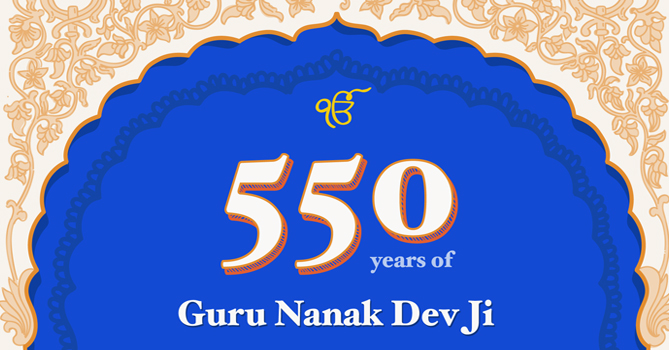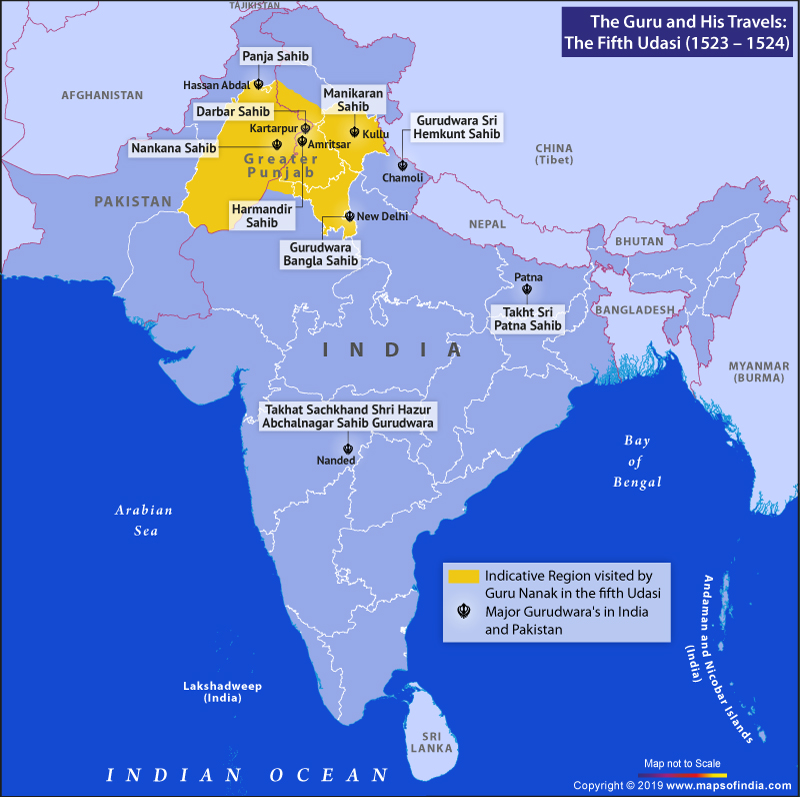

Guru Nanak Dev Ji (1469-1539) was born in Talwandi Rai Bhoe Ki, then part of the undivided Punjab region (part of present-day Pakistan) and is the Founder of the Sikh faith and First of the 10 Sikh Gurus,
At an early age (30), Guru Nanak left home on a mission to spread the message of Ik Onkar or One God. His journeys (Udasis) took him to different places in India and other countries, spanning 24 years. In all, he covered a distance of 28,000 km, most of which were on foot.
His Muslim childhood friend, Bhai Mardana, accompanied him in all his journeys, playing the Rebab – a musical instrument, as the Guru sang his divine Shabads (Hymns).
Through his Gurbani (Shabads), Guru Nanak enlightened people of the real message of God. He spoke of the existence of Ik Onkar – the one and only omnipresent formless God. Guru Nanak dissuaded people from idol worship and was against worshipping of images, as he believed that was with form or shape and was everywhere.
His was a simple message – anyone seeking salvation must lead a truthful, kind, humble, and non-violent life. A true believer must share ten percent of one’s income with those who need it.
After completing four long Udasis spread over 22 years, Guru Nanak and his companion Bhai Mardana were once again ready to undertake their Fifth Udasi.
Guru Nanak was 54 years old, and this was his last Udasi. On this journey, the Guru decided to focus on spreading the divine message in and around the Punjab region.

Everywhere he traveled, he won over people through reason, logic, and mesmerizing Shabads. His followers kept growing, and over time, several Gurdwaras were built to commemorate his visits. His divine message profoundly influenced people’s lives serving and to this day, continues to serve as a beacon of light for walking the right path.
The Janamsakhis have recorded several incidents on the impact of Guru Nanak’s discourse during his travels. We look at one of them.
Guru Nanak meets Bhai Buddha
Guru Nanak settled down in Kartarpur, in present-day Pakistan and began holding early morning Kirtans (religious prayers). He noticed a seven-year boy attending every day and listening attentively to every kirtan. Curious, the Guru called the young boy and asked him why he was so interested in attending kirtan when he should be out sleeping or playing like other children of his age.
The boy replied, “I watch my mother light the cooking fire daily and notice the smaller and thinner sticks burn first. I am afraid of dying early as I am small and thin.”
Impressed by his words, Guru Nanak blessed the young boy saying, “You are a young man, yet you speak like Buddha – an old man.”
From that day, the young boy was held in high esteem and referred to as Bhai Buddha. The next five successor Gurus after Guru Nanak were blessed by Bhai Buddha, who applied Tilak (vermillion) on their foreheads.
He is the Teacher; He is not God
Millions of Sikhs and non-Sikhs across the world recognize the value of Guru Nanak’s message and live lives according to his principles and those recorded in Sri Guru Granth Sahib.
Guru Nanak was an enlightened teacher blessed with divine knowledge. He stressed he was a simple, humble human being who looked upon all people as equal before the eyes of the one and only God.
He taught people to give up blindly following age-old superstitions, meaningless rituals, and worship of multiple Gods and idols. He was against all social evils and malpractices, including bigotry, casteism, religious intolerance, fanaticism, hatred, and violence.
Being well-read in religious scriptures of Hinduism and Islam, Guru Nanak rejected both, seeking a new path of enlightenment.
On the 550th Anniversary of Guru Nanak, we look at his teachings and message
Guru Nanak showed people the Sikhi way of life – a path built on Three Pillars:
Kirat Karni: Do honest work
Guru Nanak spoke of living based on an honest income earned through sincere physical and mental effort. He talked about the need to treat everyone fairly and with dignity and live a life of high moral and spiritual standards.
Vand Chakna: Share what you earn
Guru Nanak believed by selflessly serving others; one serves God. He said a true Sikh is one who shares ten percent of the honestly earned income with those who need it.
Naam Japo: Pray to HIS name
Guru Nanak taught people the way to walking and staying on the path of Dharam (righteousness) was through complete devotion to the Almighty – the one and only Waheguru, and through constant prayers and praise of HIM.
Guru Nanak explained Ik Onkar as only Supreme Creator and above all else.
Guru Nanak explains the existence of Ik Onkar, which is the opening composition (Mool Mantar) in the Adi Granth.
The Mool Mantar begins with:
- Ik Onkar: There is only one supreme creator who is all-pervasive.
- Satnam: He whose name is Truth
- Karta Purakh: He who is the Creator of the universe and Doer of all that runs it.
- Nirbhau: He who is fearless and righteous
- Nirvair: He who is without enmity, anger, hatred, or bias
- Akal Murat: He who is eternal and without form
- Ajooni: He who is beyond birth
- Saibhang: He who is self-existent; one who exists by itself, breaks itself, and fixes itself
- Gurprasad: The final reward is the Guru showing the way to God
Guru Nanak in the 21st Century – Relevance and Resonance
The Encyclopedia Britannica (2018) records 27 million followers of the Sikh religion.
So, what makes Sikhism so popular in the 21st century and why it continues to attract followers?
Firstly, Sikhism is a relatively younger religion as compared to other older religions like Hinduism, Judaism, Christianity, Buddhism, Jainism, and Islam.
Guru Nanak was born in 1469, an era when Hinduism and Islam were the two dominant religions in the Indian sub-continent. As Mughal rulers pushed conversion to Islam through force and incentives, it resulted in a polarized society, each deeply entrenched in propagating their traditions, rituals, and practices.
Guru Nanak witnessed the faults of both and wanted to pursue an independent path to spirituality and life. His message, as explained above, was simple – there is only one God, and all are equal before Him. People found the message appealing.
In today’s world of conflict and social disputes, societies remain polarized, and countries divided over ideology, religious beliefs, customs, and practices.
Guru Nanak was a man of spirituality, peace, and humility, qualities he wanted to see in all his followers. His message highlighting the equality of all people and community service found resonance among the youth. It was true back then; it remains true today.
Sikhism draws the best from other religions and stands out for its simplicity. The Sikhi way of life is about principles of righteousness, morality, ethics, gender equality, fairness, and justice for all.
Any person, irrespective of religion, creed, caste, or colour, can freely visit any Gurdwara anywhere in the world and join the Langar – a free community meal, cooked by volunteers. The doors of the Gurdwara remain open to all.
Sikhs have added to their reputation for bravery and valour by serving as first responders in any disaster or humanitarian need.
The commitment to selfless community service makes the Sikh community very welcome in all parts of the world.
What started as a simple message of a social and spiritual reformer has today grown into a thriving religion.




